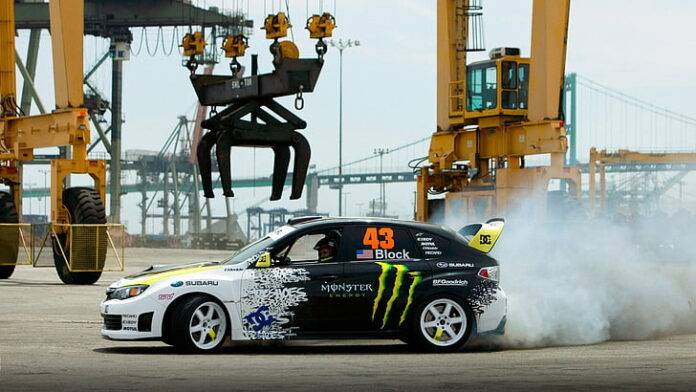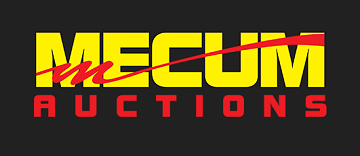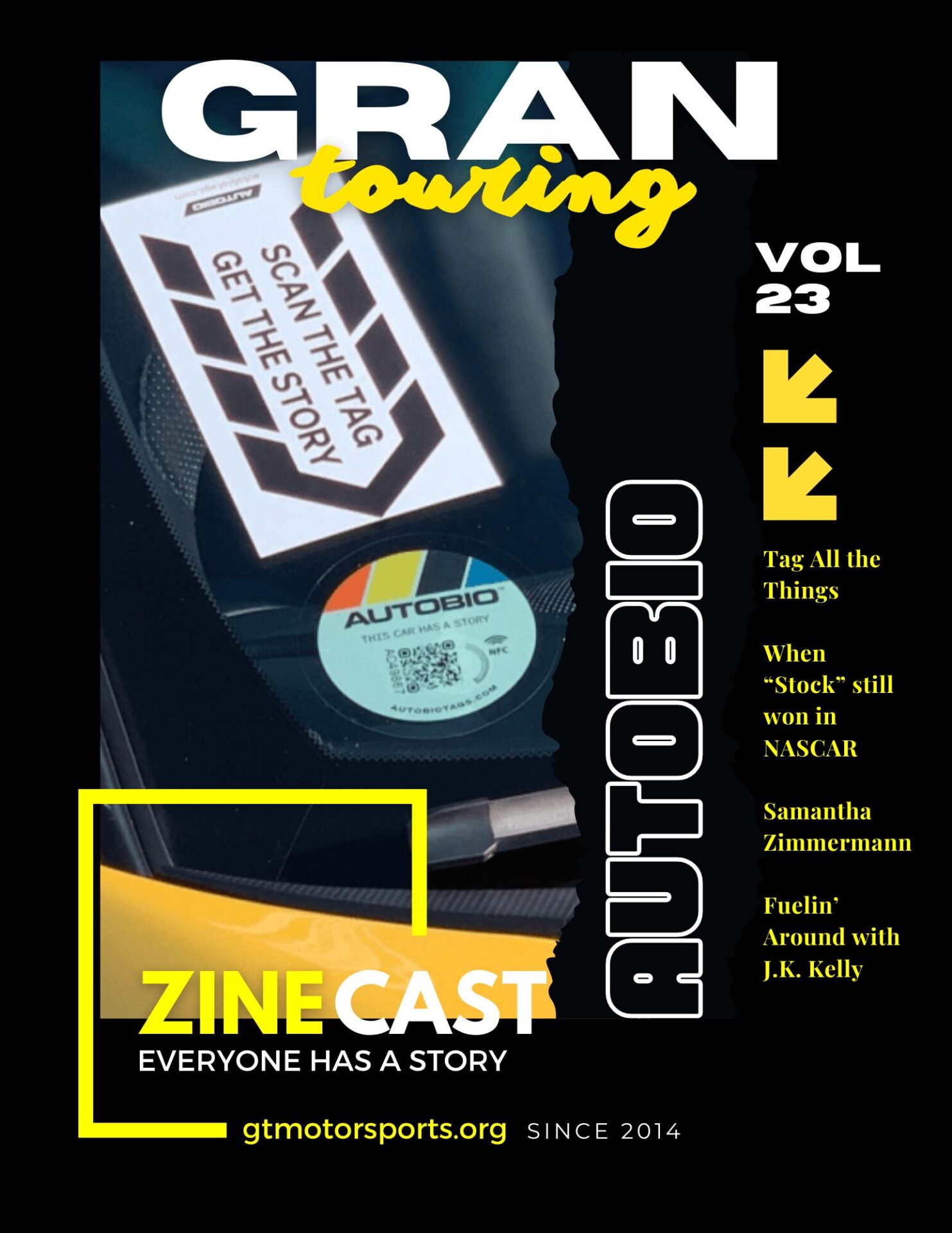In part-2 of the Mint 400 episode, we talk with Season-2 guest Matt Martelli about growing up with Ken Block, his love of Rally, and the making of the iconic, game changing Gymkhana 1-3 videos. #everyonehasastory
Tune in everywhere you stream, download or listen!
 |  |  |
- Spotlight
- Notes
- Transcript
- Highlights
- Learn More
Spotlight
Ken Block 1967-2023
Pro rally driver, co-founder of DC shoes and Hoonigan Ken Block was killed in a snowmobile accident on Monday January 2nd, 2023. Hoonigan and local authorities confirmed.

Block, a prolific figure in the car community, was 55 years old. He moved into the world of rally and quickly made a name for himself, developing the Hoonigan brand and creating the much-loved Gymkhana video series.
Notes
This is a Patreon Special re-release if you’d like to get access to more content like this without having to wait, be sure to like, subscribe and support us on Patreon.
Transcript
Crew Chief Brad: [00:00:00] We always have a blast chatting with our guests about all sorts of different topics, but sometimes we go off the rails and dig deeper into their automotive and motorsports pasts. As a bonus, let’s go behind the scenes with this pit stop mini sode for some extra content that didn’t quite fit in the main episode.
Sit back, Enjoy, and remember to like, subscribe, and support BreakFix on Patreon.
Crew Chief Eric: So Matt, let’s get back into it. You’ve name dropped something huge earlier. We mentioned Ken Block and then Jim Kahnna, and you said you were part of that. So let’s unpack that a little bit. Tell us about what that was like and how you were involved in the making of those films that a lot of us just salivate over.
You know, we can watch them over and over and over again on YouTube.
Matt Martelli: Yeah, no, absolutely. I grew up with Ken and both of us were Um, rally enthusiasts and, um, you know, we were doing some work in rally. He had sold his company and wanted to start rally racing. And, and he did, and he brought Travis Pastrana along.
And one of the things [00:01:00] that’s cool about Ken is he always has a plan, you know, like there’s, you’re like, Oh, you’re done. You’re retired. You sold your company and, you know, you’re, you’re, I think he was in his thirties still. Right. At that point, he’s like, well, I’m going to go look at this and do some things and stay on as a, you know, as an advisory person or whatever we went rally racing that was going well.
And what we started doing is documenting that. And we had a unique perspective because we grew up making skateboard films, which skateboard films by nature, you. You’re very close to the subject matter. You’re really focused on passing through the visceral experience of skateboard, you know, skateboard action.
And everything from the sound to feels like you’re there. If you watch skateboard films, it feels like you’re hanging out with the skateboarders, right? And it’s raw. And so we wanted to, or actually we didn’t even want to, we inadvertently did that when we were documenting rally. And so we started putting out video content and this is.
Right at the beginning of [00:02:00] YouTube. So we were putting out video content at the time on like Flash Player and Windows Media and Real Player . Yeah, real player. Like every time you had to do a post, you’re like, no, we have to put it up in these five formats. And it was a pain in the ass to say the least. And YouTube came along and, and at the time everybody was just suspect of it.
They’re like, what’s the scam? The game changer. Yeah. What’s the scam though? Like we’re all looking at it going like, we know how expensive video hosting is like, what’s the scam. So we were just trying to figure out how to bring attention to really to rally racing and the, the incredible vehicles and the incredible performances of the drivers.
Ken had kind of looked at Gymkhana and come up with this base concept of, you know, what if we build a four wheel drive Gymkhana car? I’m like, yeah, it sounds sick, but it sounds expensive and you know, all these different hurdles and he did it. He took his own money and you know, everybody has these theories about like how Subaru funded it or.
Somebody else, it wasn’t, it was in [00:03:00] the beginning and Ken was taking his own personal money and funding the racing and funding really everything from that point, we collectively concepted, Hey, we want to try and capture all these special moments within one video. We knew that we couldn’t do that out on a rally course.
We had to do it in an environment that was a little bit more attainable. We knew that people were doing different events in El Toro. We went up and looked at it. And to be honest, like it was really sketchy. You know, one of the things that I remember clearly about gym kind of one was, you know, we had this opening drift idea where Ken was going to go down about a hundred miles an hour and throw the car sideways and, and drift the car and do a four wheel drift.
And it was going to be rad. Right. Well, I’m out there first time looking at the car and it didn’t, wasn’t fully caged. It was a car that was prepared by one of the guys here locally, who’s a really well known Subaru car builder, Cor Crawford. And, you know, he put like one of the sissy bars in the back. I remember looking at that going.
[00:04:00] I thought this car was caged, right? You know, that was the first thing. And then the second thing was I was looking at the lips on the runway and there were, there were lips that were like four and six inches tall. So in my head, I’m imagining Ken throwing it sideways, hitting a lip and doing a pirouette and landing on the roof and die.
And I’m sitting there going like, yeah, that would be really bad. If I killed Ken at this point in his life, you know, you know, look, we went out there and we did it. And I think we completed in two or three days. It was a team of myself and my brother and a couple guys that worked for us at the time and you know, we put together the shots and the stunts, but really it was feeling like a skate film.
Like in our heads, we’re like, we’re making a skate film with a car. That was really the beginning of it. And I thought it was going to be really good. I had no idea. No, nobody did really, you know, and again, like Ken finance part of it, we finance part of it, you know, sweat equity and equipment and all that type of stuff in the beginning.
And we just thought like, Hey, this is good for everybody. And let’s see what we can do. Right. [00:05:00] And obviously it took off, but it was funny because. When we first posted it, we did the same thing where it’s like Windows Media Player, QuickTime, Flash, all on a web host and people started watching it, a lot of people, and then the web host company calls us and they’re like, Hey, you, you’re going to owe us a lot of money.
And so then we quickly then put it on YouTube and it exploded. It was really interesting for us because my biggest takeaway wasn’t that we were some geniuses or we did something that. Nobody else could have done what our takeaway is, is that people were, they were dying for good content. They were starving for it.
And, you know, there was all this bullshit that was constantly put out in the automotive space. And I don’t think since, you know, the films like climb dance was a huge influence on us. Rendezvous, some of the other early films that were shot, you know, on film about Lamar and those things that McQueen shot and Garner was involved in and people that were racers and they were [00:06:00] like, look, we don’t care.
Put the camera on the front of the car. This is how we get the shot. Right? And so that was kind of our, our mindset. And that was really due to our, our history and making films with skateboarding, because you kind of had this cavalier style of filmmaking.
Crew Chief Eric: So I have to pause you because I mean, this is fascinating.
And you should see Drew’s face. He’s just like in awe here. You named drop something that I don’t think a lot of people, except for folks that maybe grew up in the group B generation, like I did. Know the term Climb dance, that’s Ari Vains run to the top of Pikes Peak in the peo. I mean, that is an incredible film.
I actually have a copy of it. I have it privately stored on YouTube, so I wouldn’t lose it. Something like that to provide you that inspiration. I mean, hats off mad props. That’s a reach right there. I mean, outside of Rendezvous, which was one of the original. Car film shot in Paris, all in one, all in one go.
We talked about that actually on a previous episode with one of our guests, Paul Wilmosky, who’s from Hollywood and how that film [00:07:00] influenced him and whatnot. There’s a lot of mystery and allure behind Rendezvous as well. But I mean, again, we’re all petrol heads of a certain age, so it’s really cool that you bring that up.
David Andrews: Yeah. So I got to say that’s that what you just said, Eric, but that inspiration you got Matt springboarded. You guys to create what you guys created. And I want to say it was like the mid 2000s when I was introduced to that video. And I’m imagining everyone else who’s probably listening to this was you heard it from somebody who heard it from somebody.
And then when you saw it, the way you guys. Film that video was in a way that no one had ever done it before. And it was very light watching Rob Dyrdek or whoever skateboarder when they’re on the street and you’re getting like those cross shots in the action video of the vehicle going through that four wheel drift.
And I got to tell you, dang, it’s coming up on 20 years ago when that was done. I know. Right. I had [00:08:00] never seen anything like that, like, and then the drift that Ken did, nobody had ever filmed anything like that before. And I feel like what you guys did, bring boarded other creators to film like that, those crazy low, close action shots.
Crew Chief Eric: Well, not only that, I was going to say, I think you guys set the stage to be our generation’s climb dance and rendezvous and whatever, like those Gymkhana videos, when you talk, you’re like. Jim Connor and everybody goes, yeah, I know. Oh my God. It’s epic. Right. And the 27 versions of it later, but still they have set the bar really damn high at the end of the day.
So congratulations.
Matt Martelli: No, I appreciate that. And it’s, I love being a part of the timeline of, of motorsports culture like that, because there are a lot of things that influence. My brother and I as kids and one of them were the couple films I just mentioned. The other one was just growing up in the era of wide world of sports.
Crew Chief Eric: Yeah. You know,
Matt Martelli: it was a magical era of like watching TV and they’re [00:09:00] like, Oh, we’re at Isle of Man today. And we’re, they took you all over the world to all these different things. And it was spectacular and very well shot, especially for that era, because they had some very crazy limitations with film. You know, like when you.
understand rendezvous. There was no GoPros when they shot that. No, I
Crew Chief Eric: mean, look at Lamont’s. If you look at the behind the scenes of McQueen’s movie, he’s got these massive cameras mounted in the 917 and he could barely drive the damn thing. And the cameras are so big. That
David Andrews: or a helicopter.
Crew Chief Eric: Yeah. Right.
Matt Martelli: Yeah.
And, and like to the other part of it. To me, that was so impressive is in particular with climb dances. The sound is like how violent and visceral it was. And that’s one thing that we carry forward in a lot of the work that we do. You know, even now it’s like jumping forward to why, why we, you know, are involved with the mint 400.
It was because we got tired of being filmmakers and the creative sitting on the sideline, telling these old men who, you know, [00:10:00] own the. The sport, Hey, you need to do this and you need to allow us in there to shoot. And we need to have controlled environments. We need to do all these things. And they’re like, who are these kids shut up, you know?
And so it was our way of taking control and having the creatives run everything rather than the administrators, the bureaucrats, right. It was a great experience and I’m really stoked to put our stamp down, you know, on that first film and then follow up with the second and the third, we had a lot of fun and you know, I can’t speak higher of Ken too, because you know, the guy is, he’s a very unique person.
People constantly come to me and they’re like, Oh, he’s not the greatest driver. He’s definitely not the greatest driver. He never said he was, he just was trying to show people really to put light on. The vehicles and the drivers so that that people would recognize them and go, okay, drifters are badasses and rally.
Not only
Crew Chief Eric: that, after like the big names left group B or group B was disbanded in 1987, 88, and you were left with the, with the group A cars and [00:11:00] whatnot, people were like rally, forget it, Audi’s not there. And Blanche is not there. We’re not going to watch anymore. So there was like this dead zone. And I think Ken, I attribute him to revitalizing rally.
I mean, yes, Colin McRae and Carlos signs and all those names for sure. Even Yari Mati Latvala, who is now a team owner that came up through that. 90s and 2000s era of rally, but it’s just not the same. It didn’t have the same allure to your point. It wasn’t nearly as visceral as the group B cars like Ari Vatanen and Michel Mouton and Walter Wuerl and all those guys.
It was a different time. It was a different place. They could get away with more, but I think Ken. Brought it back. The thing that was most impactful and still brings the biggest question in mind is I don’t remember what Jim Conant is, but where they closed down San Francisco and we’re like,
Matt Martelli: yeah.
Crew Chief Eric: I’m like, how the heck did they do that?
Because how do you get the whole city to basically shut down and not have some random person walking their dog or they need to get. Go jogging or go to Starbucks or whatever. I mean, how do you guys manage that? [00:12:00]
Matt Martelli: Well, to be clear, we didn’t do that one, but you pay, you pay the city, you pay permits, it’s expensive.
You know, and that, that I think is one of the things too, that, that people don’t understand is, you know, it becomes a, uh, a race war, right? Like you do one and everybody’s like, Oh, wow. And then number two, we’re like, Hey, let’s go to Porta Long Beach and tap the dock and, you know, do some camera effects and.
You know, bring Robin and do some different things kind of, you know, make it have a wider appeal. Then when we got into Jim Connor three, we’re like, how do we wall ride the car?
Crew Chief Eric: That was at the autodrome, right? Yeah. That was
Matt Martelli: at the auto show who basically pissed off France, you know, entirely. But, you know, again, it was.
You know, it was a lot of fun and it was, there are a lot of challenges and it was awesome. We had a, we had a great time doing it.
Crew Chief Eric: So let me ask you this. So, you know, when you watch the videos, they’re so fluid, the editing is so seamless. Like you can’t really tell, you know, where one stops and the other one begins.
Obviously it took multiple days, [00:13:00] as you said, to put it all together. I remember watching the roof yellow bird videos. If you remember those of the guy in the loafers famously driving, you know, the twin turbo 911 around the Nurburgring. And you could tell where there was oops moments. They cut that video and put it back together.
And you’re like, oh yeah, here he comes around that corner again. And you’re like, that, that isn’t right. So, you know, what were the technical challenges with doing Jibkana? Like how many takes did it take? Did you destroy any of the cars?
Matt Martelli: We were wrecking the shit out of stuff. Like, it’s like, that’s the thing is like, it’s funny.
It’s, you know, after Gymkhana, we went on and we did a series of films for Polaris called XP1K. By the time we got to that, we’re like, look, we need three cars. You know, we need four cars because. We’re going to wreck a car and we can’t stop production. We just need to, we need to drag that car out, have the mechanics start working on it and put the guy in the next car and a lot of the stunts you’re trying stuff that you’re like, theoretically, we think we can do this.
Right. And we’re literally going, okay, [00:14:00] well. You know, Ken, I think you need to go 40 miles an hour into this and then hard break and rotate the car. And he’s like looking at me going based on what, you know, I’m like, that’s the starting point. Like, let’s do it, you know, but to your point about editing, I mean, that that’s my brother, you know, that’s one thing that it’s very special about us as a team is that he came from a music background.
So he was trained as a, as a music engineer. And so he sees things. As a music edit, as a song, right? And a song has to have beats, right? And it has to work together. And if you’re offbeat at all, people, they know what’s wrong. And so he approached editing the same way. So the level of detail that goes into the editing was really all my brother.
And it’s funny because it’s. often something that’s not talked about, but you can see it now in other films that get made that are, they’re not as fluid and they’re not thinking about, they’re not thinking about their shots. They’re not thinking about, you know, all the different variables. [00:15:00] I can tell you, like, I mean, we painstakingly.
Poured over all the details, time of day, angle of the sun, composition, color of the car, like just on and on and tried to make it better. And then lens choices and camera techniques. And now it’s funny because I feel like I ruined the world with slow mo. Because we were some of the first people to really utilize it.
And now it’s completely overused. And it’s like
Crew Chief Eric: bullet time in the matrix. Right. Figured it out. Everybody does it now. Yeah.
Matt Martelli: And then the other thing too, is like being a petrol head and going like, okay, look, this part of what the car is doing. That’s remarkable. And that’s when you slow it down, this other shit, you’re just coming in and you’re exiting, but this point, that’s the magic.
And if you don’t understand that, you’re not going to get the shot and you’re not going to nail that in the edit. And you know, that’s, that’s why even with the stuff that we do with the mint 400, it’s like, you know, after we’re done here, I got to work on script notes for our live stream, you know? So, because I want it to be right.
David Andrews: Can I say [00:16:00] something and you probably don’t give a shit, but there’s one thing that I noticed. That was different. I noticed that you guys do a lot more over the head shot versus the dead on shots. And so the earlier videos was very dead on and kind of off camber topper like shots. So when we started getting like the over the head shot to see what the vehicle dynamic was doing, that’s when I realized, aha, there is somebody behind the curtain, because that then let me know that in the earlier videos, I felt like.
Can’t like this guy is doing all this stuff first take, but then when you pay attention to the shots, you see the different tire marks on the ground and say, Oh, there was about three runs right there in that scene.
Crew Chief Eric: You have to pay really close attention.
David Andrews: And that’s what fooled me in the earlier videos because it was a lot, I feel like it was a lot more dead on, so we couldn’t see all that
Matt Martelli: that’s just camera technique and, and like us getting to the point where Jim kind of one, we had no budget.
[00:17:00] Like, so we were, we were like, Hey, we, we, we shot it entirely on Panasonic HVX cameras, which at the time we’re like cutting edge. We were some of the first people on the West coast to get our hands on them. They were the first digital cameras to have, you know, slow mo at 60 frames per second. Right. Which was pretty remarkable for the cost of the camera.
You know, when you go back and you even look at the rally stuff that we did, it was like, we would go out onto a stage. We’d find the outside of a gravel corner. I would dig a hole. I would stand in the hole with the camera and then put PVC over the front of the camera, knowing that I was going to get hammered just so we could get the gravel moving in slow mo.
And we weren’t, you know, we weren’t making any money at that point. It was fun stuff
Crew Chief Eric: that people don’t appreciate about what goes into doing that kind of stuff is you had to dig your own hole to stand in to, you know, this whole apparatus to get one shot of some gravel flying in slow motion. I mean, that’s a lot of dedication for what a [00:18:00] second or two of a shot.
Yeah.
Matt Martelli: It’s, it’s interesting. It’s like one of my favorite, as you can tell, I’m a, I’m a big food guy. Right. I’m definitely not a skinny man. You know, there’s a series that came out called chef’s table on Netflix. I don’t know if you’ve seen it, but I love it. And I really hope that somebody produces a series like that on cinematography, because I know a lot of different cinematographers who are much the same way.
And for us. You know, being car guys, like I can tell you, we, we drive around. I go spend weekends looking at locations like, Hey, I think we can do stuff here. I want to go look at it. I’m a middle of wherever the desert different countries took a vacation to Japan to look at some stuff there. Pissed my wife off, but you know, it’s part of the deal.
If you really are passionate about something, then dedicate yourself to it. You know, go all the way don’t half ass it. And there’s always going to be compromise that you’re. Forced to do, whether it’s budget sponsors or people paying for stuff that you’re doing and they don’t understand it, but what [00:19:00] we try and do as much as possible, set up a situation where, whether it’s us or people that are working for us, where they can really thrive and be creative and take those risks and try things.
And you know what, not everything works, you know, but if you’re not trying stuff, then it’s all going to be the same. And unfortunately I see a lot of that out there. I see a lot of like. Hey, I have a red camera. I’m just going to shoot everything slow mo. And then I look at it and it’s like crappy, like crappy composition.
Like, it’s like, meh, you know, that’s not good content. I always use music analogies. It’s like, I feel like, you know, the first three Jim Connors were like the first three Metallica albums. Right. And. And then consequently, after that, it was a lot of copying, a lot of the same stuff. Totally fine. Right. But it’s not those first three.
I’m really proud of the work that we did back then, you know, in those films. But I think it’s interesting because I’m glad that it influenced the whole generation of filmmakers to go out and make different films and different [00:20:00] disciplines that. Was part of the point and that’s what we had in skateboarding.
We had a war, you know, it was like every skateboard company would drop their skate film and you were always at war with each other trying to one up each other. Even to this day, you know, like I said, we, we did the XP1K series for Polaris, which is very successful. We did some really wild stuff with RJ Anderson and Polaris Razor.
You know, we continue to look for those opportunities. I mean. Our goal and kind of our mandate when it comes to that type of content is to go find the best drivers, the best vehicles and the best locations in the world and show people. It’s a question like, why did you guys fall in love with rally? I could tell you the moment I fell in love with rally and I’m sure you have similar moments, but it’s because I saw something incredible and went, wow, that is an incredible moment that happened.
And so for us, how do we capture that and share that with other people? So then they can fall in love with it and whether that’s. You know, rally or drifting or off roading. That’s what we’re interested in doing.
Crew Chief Eric: All I have to say to that is [00:21:00] amen. Amen. So Matt, you know, normally on a pit stop, we ask all sorts of fun questions like, you know, if you had a million bucks, what kind of car would you buy?
60s car of all time, this, that, and the other. But, you know, we’re going to spare you that because I have a really important question to ask you that goes right in line with everything we were talking about, which has to do with your friend, Ken Block. You know, there’s names. In the, let’s say the motorsport world that are synonymous with certain cars.
You hear Hurley Haywood, you think Brumos Porsche. You hear Colin McRae, you think Subaru. You hear Ken Block and you think Ford Fiesta.
Matt Martelli: Sure.
Crew Chief Eric: What do you think about him signing with Audi?
Matt Martelli: I think it’s cool. Like, I think. You’ve got to take those opportunities. It’s really weird to be giving somebody the gift of what I feel like we gave Subaru and then, you know, later on we gave Ford and yeah, they paid for it.
But I would always argue the fact that what they paid and what they got were completely off balance, right? I’ll give you a little analogy, an [00:22:00] average television commercial for a car is north of a million dollars. There’s very few of them that you remember. So when you look at that level of money, that’s being spent on selling a car, knowing what we achieved with Jim Connor, with Subaru, and then with Ford Fiesta.
I mean, as far as America goes, Ford Fiesta was pile of junk. And then all of a sudden a whole generation of kids wanted a Ford Fiesta. Same thing with the Subaru STI. Like what was interesting about that was that that car was dope. You know, and, and you had a generation of kids who were car builders with the whole Honda movement and they weren’t quite mature.
They, they hadn’t graduated to a BMW because of money and, you know, different things. So there was a gap,
Crew Chief Eric: but there were also a Volkswagen defectors in there. The dubbers went to Subaru as well.
Matt Martelli: Yeah. And so we recognize that and we’re like, look, this is a dope car. Then nobody knows about it. Even Subaru, they didn’t understand what they have.
And I’m like, this is a car of a generation [00:23:00] potentially. And what we did with that vehicle, it lives on forever. You know, it doesn’t go away. It’s not like a television commercial that like you stop paying for and it goes away. We stamp that into the cultural timeline of automotive forever. And I think
Crew Chief Eric: people are still trying to recreate that magic with the new cars.
And it’s not quite the same.
Matt Martelli: You know, again, it’s like, you have to get down to the basics, right? I’ll use the Metallica album again. It’s like, I’m a big Metallica fan, but like. They’re new albums. Like that’s not Metallica, right? So at some point you got to put all the fancy stuff down and get back to the dirt and get down to the nucleus of why it’s special.
And a lot of people don’t want to do that, man. They don’t want to do the work. They don’t want to put themselves in that position. It’s hard. We’ve done some really crazy shoots that I can go into details and you’re like, why would you ever do that? And it’s because, you know, we are trying to do something better, different, more visceral, and create the impact that we.
Felt when we were kids and watching wide world sports and
Crew Chief Eric: ESPN eight, the [00:24:00] Ocho, right?
Matt Martelli: And like you, you kept mentioning group B I’ll back this up into one of your questions of like, you had a million bucks or a limited budget. What car would you buy and drive? I’d buy a group B car. A hundred percent.
Thank God
Crew Chief Eric: somebody agrees with me.
Matt Martelli: It would be so fun to just offend everybody violently driving around town. And it’s just visceral rock.
Crew Chief Eric: All right. All right. All right. So since you brought it up. Best group B car, in your opinion, the one you would buy, if you could buy one.
Matt Martelli: You know, that’s a hard decision because I like ugly cars, right?
Crew Chief Eric: Oh, man. He’s going for like an MG Metro or something terrible.
Matt Martelli: No, I don’t know. Like that, honestly, that’d be a really hard decision because like, you know, the funkier, the better, the more like. You know, in your face, the better. So honestly, it’d be hard to decide, but I mean, even the Audi’s were dope. So, you know, it just, it just depends.
Right.
Crew Chief Eric: Personal note, I’ve owned a UR Quattro, never drive your heroes. I’m going to say that I’ve driven an [00:25:00] R5 turbo to never drive your heroes. Just going to repeat that again. I’ve driven a bunch of the homologated cars or owned a few, but I’m trying to look
David Andrews: at, I remember that car.
Crew Chief Eric: So I’m right there with you.
I think because I grew up in a VAG family, I’d have to buy an Audi S1 or even a long, a long wheelbase Audi, just because there’s nothing like the sound of a five cylinder I’m all the boxer engine fans. I’m sorry. The five cylinder is a dragon with its tail on fire. Why don’t
Matt Martelli: you do that? That’s it’s funny because that’s part of it.
It’s like really this hit home with me. We did an event in Germany years back called power days, and we actually. We took Ken Block and we took BJ Baldwin. The idea was that we were going to go show Europe what we were doing and connect rally with off road. And so we took trophy trucks over there and, you know, we did this big event and, you know, it was really cool.
But one of the things I learned is that the power of sound, we started the trophy trucks up and started [00:26:00] backing them out of these secrets, thousands of people just surrounded us. They’re like, Oh, that sound that’s incredible. I’m like. Yeah, it’s cool. This isn’t even a big block. Like this is just a, you know, small block V8, like it’s straight pipes.
So it’s a little bit more violent than normal, but they couldn’t understand the sound. I realized at that point, unless you grew up in North America, you’ve never heard that. Yeah. And it made me understand like how valuable sound is to your experience. Right. And whether it’s. on film or whether it’s you there in person and you feel it in your chest, right?
So that, that I think was one of the things that was magical about the group beer. It was like, you’d hear these vehicles and you’re like, it’s going to explode. It sounded like it was going to blow to pieces and it got louder and more violent as it got near you or near to the camera position, you know, and, and they were just, Spectacular horsepower, spectacular drivers, spectacular crashes.
It was totally punk rock. And I think that that’s a very important thematic to hold on to in [00:27:00] racing. It’s like, look, I’m a race promoter. I understand all the problems that we have with insurance and all these different things, but cannot lose that punk rock ethos of like, look, at the end of the day. What we’re doing here is we’re having a polite fist fight and when we forget that and we make it too poofy, then there’s no point.
Crew Chief Eric: Well, and we say that all the time in the road racing world that if you want to go to a professional event and you want to get close and you want to get in the pit and you want to see engineers and you want to see drivers and take your selfie with anybody that’s there. Yann Magnussen is an example, right?
I mean, we did that. IMSA is the way to go. WEC, any of the prototype or GTL MM cars. I mean, you can get in there with those guys. They’ll talk to you. They’re super friendly. You go to an F1 event, no offense. They’re great to watch. They’re a lot of fun, but it’s always, everything’s at arm’s length and it just doesn’t have the same draw.
But because IMSA like rally started in Trans Am and SCCA, and it came up through that world, it still has that grassroots appeal, [00:28:00] much like you guys are bringing to the table with the mid 400 is it’s such a prestigious event where you can still get in there. You can still be hands on and be in the action in part of the event, be part of history.
You know, Matt, as we wrap this Pitstop up, amazing again, mind blowing information here, I do want to ask one question because you brought it up and it is a Pitstop question that we usually ask, but since you’re a fan of ugly cars, what’s your favorite ugly car and what’s the ugliest ugly car in your opinion?
Wow,
Matt Martelli: man. So VW bugs, man, I love them. They’re funky. And it’s funny because part of it’s childhood, I guess. Part of it is regional where we live. Yeah. VW bugs. Continue to be made in Mexico for years after they were discontinued in the U S up to 2003. Yeah. And so we’re right on the border. We have a lot of Mexican friends.
We spent a lot of time in Baja and they like, they go crazy over class 11 VW bug racing, and it’s very serious. Right. And so I just love that. I love that somebody just [00:29:00] picked a completely out of date and practical vehicle, and it was like, this is what we’re going to fall in love with.
Crew Chief Eric: Yeah, that’s rad.
Matt Martelli: Man, ugliest cars.
Crew Chief Eric: Ugly of the ugly, the fugliest one you can think of.
Matt Martelli: The Toyota 86, the Hachiroku that started drifting really, like, that thing’s funky, man. You know,
Crew Chief Eric: like, you think the AE86 is ugly? I mean, I always looked at that as Toyota’s bad copy of the Scirocco.
Matt Martelli: Which I think the Scirocco’s ugly, too.
Oh, all
Crew Chief Eric: right, then. All right, then. All right, then.
Matt Martelli: At least, at least you can look at a VW and go like, yeah, man, that’s like a poor guy’s Porsche, you know what I mean? It’s like saying, yeah, I’m broke. It’s okay. You know, like, well,
Crew Chief Eric: very cool. Thank you again. This has been a lot of fun.
Matt Martelli: Likewise. I appreciate it guys.
Thanks for having me.
Crew Chief Eric: We hope you enjoyed another awesome episode of break fix podcasts brought to you by grand Torrey motorsports. If you’d like to be a guest on the show [00:30:00] or get involved, be sure to follow us on all social media platforms at GrandTouringMotorsports. And if you’d like to learn more about the content of this episode, be sure to check out the follow on article at GTMotorsports.
org. We remain a commercial free and no annual fees organization through our sponsors, but also through the generous support of our fans, families, and friends through Patreon. For as little as 2. 50 a month, you can get access to more behind the scenes action, additional Pit Stop minisodes, and other VIP goodies, as well as keeping our team of creators Fed on their strict diet of Fig Newtons, Gumby Bears, and Monster.
So consider signing up for Patreon today at www. patreon. com forward slash GT Motorsports. And remember, without you, none of this would be [00:31:00] possible.
Highlights
Skip ahead if you must… Here’s the highlights from this episode you might be most interested in and their corresponding time stamps.
Learn More

Gymkhana 1
Gymkhana 2
Gymkhana 3
Guest Co-Host: David Andrews
In case you missed it... be sure to check out the Break/Fix episode with our co-host. |  |  |




























